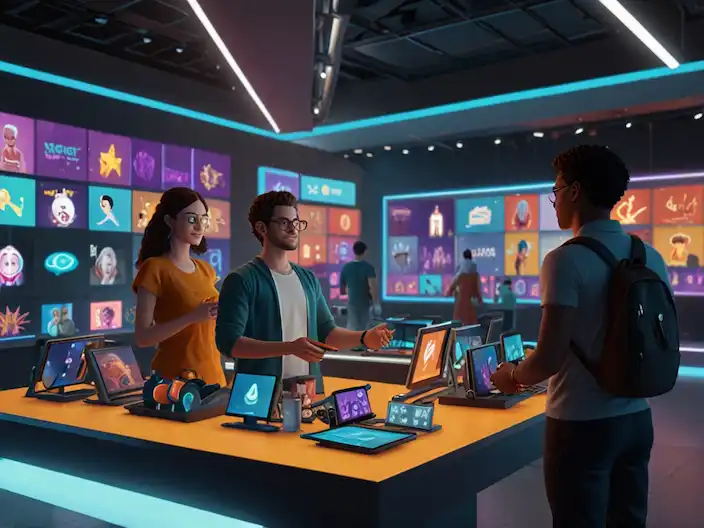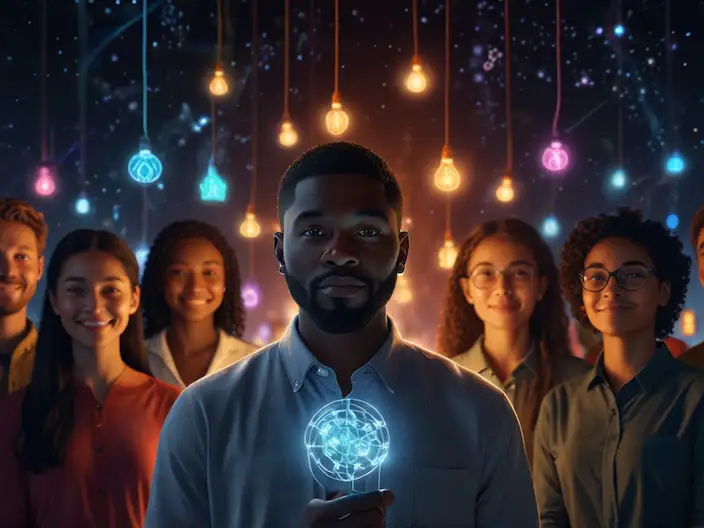- Introduction
- Key Technologies in Avatar Personalization
- Photorealistic Rendering
- Automatic Avatar Generation
- Motion and Voice Imitation
- Digital Avatars: A Bridge Between the Real and Virtual Worlds
- The Art of Personalization: Your Avatar, Your Identity
- Facilitating Communication
- Strengthening Connections and Communities
- Advanced Technologies for Creating Unique Avatars
- Dynamic AI: Evolving Avatars Based on Interactions
- Social and Sociological Impacts
- The Role of Avatars in Social Identity
- Human Relationships in the Metaverse
- Educational and Learning Impacts
- Cultural and Global Impacts
- Enhancing Cross-Cultural Understanding
- The Importance of Diversity and Inclusion in Avatar Design
- Economic Opportunities
- New Prospects for Businesses and Brands
- Psychological and Emotional Impacts
- Privacy and Ethics in the World of Avatars
- Technological Challenges and Limitations
- Future Trends in Avatar Personalization and Integration with Emerging Technologies
- Conclusion
Introduction
In the era of digital transformation, the metaverse has emerged as a groundbreaking domain that blurs the boundaries between reality and imagination. It provides a limitless space for human interaction, content creation, and identity representation. Within this virtual realm, avatars play a pivotal role. They are not merely digital images but dynamic and living representations of users’ personalities, beliefs, and creativity. Avatars serve as a bridge between the physical and digital worlds, enabling individuals to create and present unique versions of themselves.
Designing personalized avatars goes beyond entertainment—it is a tool for profound self-representation, creativity, and even social understanding. Through their avatars, users craft personal narratives, highlight their uniqueness, and simultaneously become part of diverse virtual communities. Every choice, from appearance and attire to movement and interaction, conveys a message that shapes a digital identity which might not be as easily expressed in the real world.
As digital identity gains significance in virtual spaces, avatars have become essential tools for conveying individual and social identities. They are not only means of interaction but also pathways for creativity and relationship-building in the digital world. This trend highlights that avatars are not just images but deep reflections of human experiences within the metaverse.
This article delves into the process of designing personalized avatars in the metaverse and examines their role in representing user identity. From cultural and social impacts to psychological and technological potential, we explore various aspects of this subject and demonstrate how avatars represent individual identities while shaping collective experiences in these digital realms.
Key Technologies in Avatar Personalization
Personalized avatars are the cornerstone of user experience in the metaverse, with innovative technologies playing a significant role in their development. Recent advancements in graphics, artificial intelligence, and virtual reality have elevated avatar design from a simple experience to a sophisticated and dynamic art form. The integration of cutting-edge technologies, such as AI and VR, with psychological sciences enables users to design avatars that cater not only to aesthetic preferences but also to emotional and psychological needs. This combination offers a richer and more personalized experience in metaverse interactions. Below are four key technologies shaping the evolution of avatar personalization:
· Photorealistic Rendering: Recreating Realism in the Digital World
Photorealistic rendering technology leverages advanced graphics engines and integrates with virtual reality (VR) and augmented reality (AR) to deliver a hyper-realistic avatar experience. These technologies use precise 3D scans to replicate physical features such as facial structure, skin, and even detailed clothing textures.
Photorealistic rendering allows users to create visually accurate avatars that can either reflect their real selves or embody an idealized version. This level of realism enhances immersion and fosters a deeper connection to avatars.

· Automatic Avatar Generation: Simplifying Design with AI
Artificial intelligence has simplified the complexity of avatar design for everyday users. Advanced algorithms now create accurate, user-specific avatars from simple inputs, such as a selfie. These algorithms analyze facial features, skin tones, and body shapes to generate highly personalized avatars.
This technology makes avatar creation quick and accessible, eliminating the need for professional design skills in graphic design or 3D modeling. Users can design an avatar that best represents their identity in just minutes.
· Motion and Voice Imitation: Breathing Life into Avatars
Transformative advancements in motion capture and voice synthesis technologies have enabled avatars to replicate users’ movements and voices in real time. These capabilities allow avatars to mimic body gestures, facial expressions, and even speech patterns.
This creates a more vibrant and natural experience, significantly enhancing interactions in the metaverse. For instance, during virtual meetings or events, users can communicate in a lifelike manner using their avatars, fostering a stronger sense of presence and interaction.
· Digital Avatars: A Bridge Between the Real and Virtual Worlds
This section explores the fundamental concept of avatars in the metaverse, emphasizing their role as a link between physical and digital realms. Key aspects include:
- How avatars reflect real or ideal identities.
- Reducing the gap between the digital space and daily life.
- The importance of creating an authentic presence in virtual environments such as work meetings, educational sessions, and social interactions.
The Art of Personalization: Your Avatar, Your Identity
This section delves into the intricacies of avatar customization, explaining how users can utilize available tools to create unique avatars. Key topics include:
- Customization Tools
From skin tone, hairstyle, and clothing to unique features like tattoos or scars.
- Impact on Ownership and Confidence
How personalization enhances a sense of ownership and boosts user confidence.
- Freedom of Expression
Enabling users to create avatars that reflect their cultural, social, or even imaginary identities.

Facilitating Communication
In the absence of physical cues, avatars bridge the gap between individuals, enabling non-verbal communication through gestures, facial expressions, and body language. Advanced avatars can even replicate real movements and emotions using technologies such as motion tracking and facial recognition.
- Educational Settings
Avatars act as intermediaries between teachers and students, allowing learners to participate in classes and interact without geographical or physical restrictions, enhancing engagement and effectiveness.
- Social Interactions
Virtual events using avatars simulate real-world dynamics, like group discussions and networking.
- Reducing Barriers
For shy or socially restricted individuals, avatars create a sense of comfort, encouraging interaction.
Strengthening Connections and Communities
In virtual spaces where human interaction is vital, avatars contribute to building relationships and forming communities. Their appearance, movements, and interaction styles influence how users perceive and connect with each other.
- Social Bonds
Customized avatars spark conversations and connections based on shared interests or unique designs.
- Professional Collaboration
In virtual workspaces, avatars enhance team collaboration by providing a visual and interactive presence.
Advanced Technologies for Unique Avatars
This section focuses on technologies that facilitate avatar creation, including:
- Artificial Intelligence (AI)
Machine learning algorithms suggest avatar features based on photos, voice, or user preferences.
- Blockchain
Utilizing NFTs to establish digital ownership of avatars and their components.
- Augmented Reality (AR) and Virtual Reality (VR)
Advanced techniques for creating interactive avatars that navigate 3D environments.
- Biometrics
Reflecting users’ facial expressions and body movements in live avatars.
Dynamic AI: Evolving Avatars Through Interaction
Advanced AI systems enable avatars to learn and evolve over time. These avatars adapt based on user behavior, the metaverse environment, or seasonal changes.
For example:
- Changing outfits based on weather or events.
- Acquiring new personality traits through interactions with other users.
This dynamism transforms avatars from mere digital representations into interactive, living entities that continually evolve.
Social and Sociological Impacts
- Avatars and Social Identity
Avatars represent users digitally and play a key role in shaping social identity. From appearance and attire to interaction styles, they serve as tools for self-expression in the metaverse, particularly in virtual communities and online games.
- Human Relationships in the Metaverse
Avatars facilitate connections, whether interacting with old friends, meeting new people, or establishing professional relationships.

Educational and Learning Impacts
- Virtual Education with Avatars
Avatars enhance student engagement in educational settings. For instance, teachers can use avatars to create more interactive and engaging learning environments.
- Skill Development
Avatars allow individuals to practice skills such as presentations, foreign language conversations, or professional behaviors in simulated environments.
Psychological and Emotional Effects
- Empowerment and Confidence
Well-designed avatars can boost user confidence.
- Reducing Bias
Avatars help overcome unconscious biases by allowing users to present themselves in diverse ways.
- Therapeutic Applications
Interacting with avatars can serve as a therapeutic tool, helping users address challenges like social anxiety.
Privacy and Ethics in the Avatar World
This section highlights the ethical and security challenges associated with avatars:
- Privacy
Risks related to sharing biometric and personal information in the metaverse.
- Intellectual Property
Legal issues surrounding the design and sale of digital assets.
- Ethical Boundaries
Preventing avatar misuse or identity theft.
Cultural and Global Impacts
- Promoting Cross-Cultural Understanding
Avatars featuring cultural attire and symbols enable cultural exchange, fostering global respect and understanding.
- Diversity and Inclusion in Avatar Design
Emphasizing the importance of creating a space where all users can reflect their identity. For people with disabilities, personalized avatars provide an equal opportunity to represent themselves without physical limitations.
- Cultural Representation
Options for attire, symbols, and makeup reflecting diverse cultures.
- Gender Equality
Features that allow users to express their gender identity free from stereotypes.
- Support for People with Disabilities
Designing avatars that include prosthetics, wheelchairs, or other assistive devices for accurate representation.
Economic Opportunities
Brands use avatars as advertising tools in the metaverse. For example, virtual clothing or products worn by popular avatars can directly impact real-world sales, creating a dual marketing effect in both physical and digital realms.
New Opportunities for Businesses and Brands
- New Markets
The metaverse opens new markets for products and services related to avatars. Brands can monetize through selling customization tools, digital outfits, and accessories.
- Supplementary Services
Beyond product sales, brands can offer services like custom avatar design or tutorials on their usage, enhancing user experience and profitability.
The economic potential of avatars is growing:
- Designers can create and sell unique clothing and accessories.
- Brands, fashion companies, and tech firms collaborate with platforms to offer virtual products.
- Consumers invest in high-quality or exclusive avatar customizations.
- Digital asset markets facilitate buying, selling, and trading avatar outfits, accessories, and styles.

Technological Challenges and Limitations
- Technological Constraints
Despite significant advancements, avatar technology faces challenges like the need for powerful hardware, high costs, and quality limitations in precise user representation.
- Cultural and Ethical Issues
Designing avatars must address cultural and ethical sensitivities to avoid misunderstandings, ensuring respect for diversity and cultural nuances.
Future Trends in Avatar Customization and Integration with Emerging Technologies
- Integration with Other Metaverses
In the future, avatars may become usable across multiple platforms. This concept, known as “multi-platform avatars,” can unify user interactions in various environments.
- Advanced Artificial Intelligence
AI can enhance avatar capabilities, enabling them to analyze user behaviors, provide automatic suggestions, or even represent users in virtual meetings.
- Connection with Mixed Reality
The combination of avatars with augmented and virtual reality could allow users to be present in both real and virtual environments simultaneously, offering a unique, futuristic experience.
- Holographic Avatars
Advances in holography may soon enable avatars to appear in the real world.
- Biometric Integration
Avatars could incorporate real-time biometric data, such as heart rate or facial expressions, to reflect users’ emotions more accurately.
- Decentralized Avatars
Blockchain technology supports avatars that are transferable across various metaverse platforms, preserving users’ digital identities and assets.
- Integration with Wearables
Smart wearables like augmented reality glasses and haptic suits allow users to receive feedback from the metaverse, deepening their interaction with avatars.
Conclusion
With technological advancements and the expansion of digital worlds, avatars have become a central element of the metaverse experience. These digital embodiments are no longer mere tools for navigating virtual spaces but have evolved into powerful means for expressing identity, enhancing human interactions, and redefining social and personal experiences.
Key technologies, such as photorealistic rendering, automatic avatar generation, motion and voice mimicry, and dynamic AI, have provided unprecedented possibilities for avatar design and customization. These tools combine scientific precision, artistic creativity, and artificial intelligence to create immersive experiences that enable users to craft meaningful and unique digital identities.
Through photorealistic rendering, avatars achieve a level of realism that enhances the sense of presence. Automatic avatar generation using AI has made the process accessible to everyone, while motion and voice mimicry technologies deliver natural and interactive experiences. Finally, dynamic AI transforms avatars from static entities into adaptive systems capable of evolving based on interactions and environments.
These technologies empower users not only to represent themselves creatively and accurately but also to elevate social interactions to new heights. Personalized avatars serve as more than just tools for exploring the metaverse—they are vehicles for self-expression, building digital communities, and fostering deeper interactions in virtual worlds.
Looking ahead, avatars are set to become increasingly intelligent, realistic, and personalized. They will play pivotal roles not only in the metaverse but also in fields such as education, healthcare, gaming, and commerce. Ultimately, avatars represent the convergence of humanity and technology, shaping a future where the boundaries between the physical and virtual worlds blur like never before.
Table of Contents
Toggle

